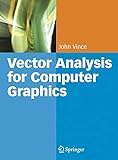Vector Analysis for Computer Graphics / by John Vince.
Tipo de material: TextoEditor: London : Springer London, 2007Descripción: xiii, 259 páginas 185 ilustraciones recurso en líneaTipo de contenido:
TextoEditor: London : Springer London, 2007Descripción: xiii, 259 páginas 185 ilustraciones recurso en líneaTipo de contenido: - texto
- computadora
- recurso en línea
- 9781846288043
- T385
Springer eBooks
Scalars and Vectors -- Vector Representation -- Straight Lines -- The Plane -- Reflections -- Intersections -- Rotating Vectors -- Vector Differentiation -- Projections -- Rendering -- Motion.
Vector analysis is relatively young in the history of mathematics, however, in the short period of its existence it has become a powerful and central tool in describing and solving a wide range of geometric problems, many, of which, arise in computer graphics. These may be in the form of describing lines, surfaces and volumes, which may touch, collide, intersect, or create shadows upon complex surfaces. Vector Analysis for Computer Graphics provides a complete introduction to vector analysis, especially within the context of computer graphics. The author shows why vectors are useful and how it is possible to develop analytical skills in manipulating the vector algebra. Each topic covered is placed in the context of a practical application within computer graphics. The book is divided into eleven chapters covering the mathematical foundations of vector algebra and its application to lines, planes, intersections, rotating vectors, vector differentiation, projections, rendering and motion.
Para consulta fuera de la UANL se requiere clave de acceso remoto.


